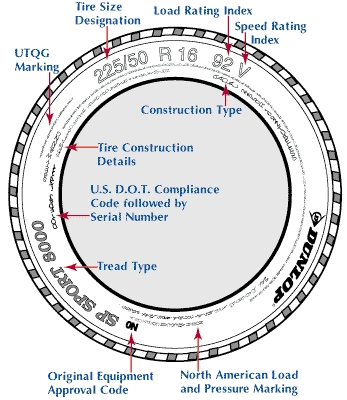Have you ever wondered what all those cryptic numbers and letters on a tire sidewall mean?
Here’s your personal decoder for the most important items:
From Consumer Reports, Jan. 1996
Size and Shape / Speed Rating / Tread Wear Rating Traction and Temperature / Date of Manufacture
Maximum Tire Pressure
Size and Shape
Typically, the tire size looks something like P185/70R14. The “P” means a passenger-car or light-truck tire; “LT” means a tire for light-truck use only. (Some tires omit that.) The next three digits tell you how wide the tire is, in millimeters (here 185 mm).
Large and high-performance cars tend to have wide tires, greater than 200 mm. The two digits after the slash are the “aspect ratio” – the ratio of the height of the sidewall to the tire width. Here, the sidewall height is 70 percent of the width, or about 130 mm. Performance tires tend to have a low aspect ratio – usually 60 or less – and a squat appearance.
The “R” simply means radial ply – a design used for virtually all tires. The two digits at the end are the diameter of the wheel, in inches.
Speed Rating
Some tires have an additional letter either with the size designation, before the “R” (185/70SR14) or just after the wheel diameter. Such letter codes reflect the maximum speed the tire is certified to sustain. Conventional tires may carry an S(112 mph) or T (118 mph) speed rating or none at all. Most performance tires carry an H (130 mph); ultra-high-performance tires, a V (149mph), Z (149-plus), W (168 mph) or Y (186 mph).
Tread Wear Rating
This is a measure of how well a tire’s tread will wear, compared with a “reference” tire graded at 100. Theoretically, a tire with a wear index of 450 (relatively high) should last three times a long as one with an index of 150 (relatively low). Tire makers conduct these tests themselves.
Traction and Temperature
Scores are for Government tests for stopping on a wet surface and resisting the effects of high temperatures. Ranks are given as A, B, or C. “A” is best, “C” is worst.
Date of Manufacture
Every tire has a US Department of Transportation serial number – something like DOT DBUA A44 414 GCD 415. The last three digits tell you the week and year the tire was made; thus, 415 indicates that the 41st week of 1995.
Maximum Pressure
The tires highest safe inflation pressure, in pounds per square inch (for example, 35 PSI MAX PRESS). It’s best to follow the inflation recommendations in the car owner’s manual. In any case, don’t exceed the maximum listed on the tire. Buy an inexpensive tire gauge to keep in your glove compartment.








